Administrator
Taiwan offshore wind market set to grow multifold with energy transition towards sustainable power mix goal, says GlobalData
Taiwan offshore wind market is poised to witness multifold expansion to reduce its reliance on fossil fuel generation and build a cleaner sustainable power generation mixture. Taiwan is estimated to build around 15GW of offshore wind capacity by end of 2035, says GlobalData, a leading data and analytics company.
 The offshore wind segment has become more active since 2019. GlobalData forecasts that the country’s offshore wind capacity is expected to reach over 4.5GW by 2025, thereby expanding to 10.1GW by 2030 and reaching more than15GW by 2035, thus becoming the largest offshore market after China in the Asia-Pacific (APAC) region.
The offshore wind segment has become more active since 2019. GlobalData forecasts that the country’s offshore wind capacity is expected to reach over 4.5GW by 2025, thereby expanding to 10.1GW by 2030 and reaching more than15GW by 2035, thus becoming the largest offshore market after China in the Asia-Pacific (APAC) region.
Somik Das, Senior Power Analyst at GlobalData, comments: “Taiwan has favorable conditions for offshore wind with wind speeds of almost 10-12m/s in the Taiwan Strait. The country drew attention of several international wind developers and investors due to its commitment to the development of offshore wind energy. Amongst them are some EU-based companies, such as EnBW Energie Baden-Wurttemberg AG, WPD offshore GmbH, Copenhagen Infrastructure Partners, and Denmark-based Orsted Ltd.”
To support clean energy, in 2016, the government announced to phase out nuclear power plants completely before 2025 and reach its target of 20% renewable energy supply by 2025. The move also helps to attain environmental sustainability and reduce the nation’s carbon footprint. With coal forming almost 48% of the generation mix, the nation was ranked third to last in the 2019 Climate Change Performance Index (CCPI).
Das concludes: “Taiwan is blessed with high offshore potential, providing greater market size and stability, conducive policy environment, established Power Purchase Agreement (PPA) market, and project financing ease, which are predicted to act as the multipliers that will ensure Taiwan is presented as the most attractive offshore market in APAC region.”
- Comments provided by Somik Das, Senior Power Analyst at GlobalData
- This press release is written using data and information sourced from proprietary databases, primary and secondary research, and in-house analysis conducted by GlobalData’s team of industry experts
About GlobalData
4,000 of the world’s largest companies, including over 70% of FTSE 100 and 60% of Fortune 100 companies, make more timely and better business decisions thanks to GlobalData’s unique data, expert analysis and innovative solutions, all in one platform. GlobalData’s mission is to help our clients decode the future to be more successful and innovative across a range of industries, including the healthcare, consumer, retail, financial, technology and professional services sectors.
Brazil dominates global deployment of upcoming FPSOs, says GlobalData
A total of 18 planned and announced Floating Production Storage and Offloading (FPSO) projects are expected to be deployed offshore Brazil during the outlook period 2020–2025, the highest among the countries globally, according to GlobalData, a leading data and analytics company.
The company’s report: ‘Global FPSO Industry Outlook, 2020−2025 – Petrobras Drives Global Upcoming FPSO Deployments’ reveals that Brazil also leads the crude production capacity globally through upcoming FPSOs with more than 2,000 thousand barrels per day (mbd) during the outlook period.
Among the 18 upcoming FPSO’s to be deployed in Brazil by 2025, eight are planned with identified development plans while nine are early-stage announced FPSOs that are undergoing conceptual studies and may be approved for development. Petroleo Brasileiro SA (Petrobras), the state-owned company of Brazil, leads the operators’ list with seven FPSOs.
Haseeb Ahmed, Oil & Gas Analyst at GlobalData, comments: “In Brazil, the announced FPSO for the Carcara field is expected to have the highest crude oil production capacity during the outlook period with 220 mbd, followed by FPSOs for Mero 4, Mero 3, Mero 2, Guanabara MV31 and Carioca MV30 with 180 mbd each by 2025.”
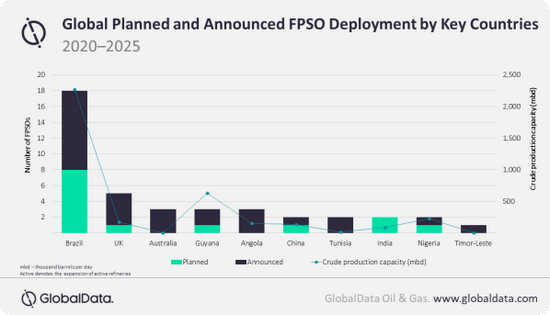
GlobalData identifies the UK as the second highest country globally with five upcoming FPSOs by 2025. Four of the upcoming FPSOs in the country are announced FPSOs. Rosebank, the announced FPSO operated by Equinor UK Ltd, has a crude oil production capacity of 100 mbd, while Penguins, the sole planned FPSO in the country, is expected to have a capacity of 45 mbd during the outlook period.
Australia, Guyana and Angola follow next with the deployment of three FPSOs each. While all the three deployments of Australia and Angola are announced projects, Guyana has two announced and one planned project during the outlook period. The top five countries are expected to contribute more than three quarters of global crude production capacity through FPSOs by 2025.
- Comments provided by Haseeb Ahmed, Oil & Gas Analyst at GlobalData
- Information based on GlobalData’s report: Global FPSO Industry Outlook, 2020−2025 – Petrobras Drives Global Upcoming FPSO Deployments
- Announced/Planned: Denotes only new-build assets that are in different stages of development and have not started commercial operations
- A new-build project that has not received relevant/ required approvals to develop/build the project is considered as Announced
- A new-build project that has received relevant/ required approvals is considered as Planned
- This report was built using data and information sourced from proprietary databases, primary and secondary research, and in-house analysis conducted by GlobalData’s team of industry experts.
About GlobalData
4,000 of the world’s largest companies, including over 70% of FTSE 100 and 60% of Fortune 100 companies, make more timely and better business decisions thanks to GlobalData’s unique data, expert analysis, and innovative solutions, all in one platform. GlobalData’s mission is to help our clients decode the future to be more successful and innovative across a range of industries, including the healthcare, consumer, retail, technology, energy, financial and professional services sectors.
XAAR 2002 PRINTHEAD DELIVERS EXCEPTIONAL PRINT PERFORMANCE STRAIGHT OUT OF THE BOX
Xaar, the leading inkjet printing technology company, has launched a highly advanced, simple to install printhead, following close collaboration with its global OEMs.
Designed to deliver exceptional 720 dpi print resolution quality and performance across a range of applications including ceramics, glass, packaging and label applications, the new Xaar 2002 has been developed specifically to provide fast and easy integration and is ready to use straight out of the box.
Using drop in printhead alignment, mechanical tolerance improvements allow the printheads to be dropped into the printbar easier, making set-up times faster, and machine builds quicker.

Developed following OEM and customer feedback, the ‘plug and print’ capability significantly reduces set-up times and helps save time and money.
In addition, thanks to its new advanced Tuned Actuator Manufacturing - TAM2 - and Xaar AcuChp Technology, the Xaar 2002 also delivers visibly improved colour uniformity across the width of the printhead, further reducing printhead installation and set-up times, therefore maximising uptime.
Print speed is greatly enhanced with the Xaar 2002, enabling lines to be run faster. By using the full capability of the printhead, much higher firing frequencies of up to 36 kHz are now possible, delivering significantly increased printing speeds of up to 75 metres per minute at 720dpi.
Graham Tweedale, General Manager of Xaar’s printhead business unit said; “After extensive collaboration with our global OEMs we worked hard to ensure the Xaar 2002 delivers the operational improvements they have asked for.
“With its simple installation and significantly reduced set-up times, we believe the Xaar 2002 printhead offers the speed and performance our customers now demand for the print applications they provide.”
Each Xaar 2002 printhead can be customised by OEMs, ensuring visibility of their brand on the print engine. Furthermore, the Xaar 2002 is serviceable, lowering the total cost of ownership and providing an excellent return on investment.
Designed for use across a variety of applications and ink types the Xaar 2002 is available in three printhead variants – the Xaar 2002 Plus, Xaar 2002 Premium and Xaar 2002 Advanced, providing customer choice and flexibility for a range of print applications.
The Xaar 2002 printhead also incorporates Xaar’s industry leading TF Technology, High Laydown and Ultra High Viscosity printing capabilities. These provide users with significant performance improvements when compared to other printhead designs. Xaar’s unique TF Technology allows a broader range of ink or other fluids to flow directly past the back of the nozzle at very high flow rates. This prevents the nozzle from drying out, increasing the printhead’s nozzle open time, thereby ensuring the printhead is continuously primed for trouble free start-up, even after periods of non-use.
Incorporating many of the performance features requested by customers, the Xaar 2002 is the first printhead to launch under Xaar’s new leadership team and demonstrates the focus on its new strategy.
“The Xaar 2002 range offers all round ease of set up and use, while delivering the exceptional print quality, unsurpassed reliability and unique technologies Xaar is renowned for,” concluded Graham. “Saving time and maximising print results for our customers, whatever their application.”
The Xaar 2002 is fully backwards compatible with printers already using the Xaar 2001+.
About Xaar
Xaar is a world leader in the development of digital inkjet technology. Our technology drives the conversion of analogue printing and manufacturing methods to digital inkjet which is more efficient, more economical and more productive than the traditional methods which have been in use for years.
We design and manufacture printheads as well as systems for product decoration and industrial 3D Printing which use our inkjet technology. We are the only truly independent inkjet technology company with 30 years of know how.
We offer unrivalled inkjet expertise including technology and printhead design and development and manufacture highly customised product decoration systems and industrial 3D Printing for volume manufacturing. Our unique technologies and products are the leading enabler for innovation and for driving supply chain efficiencies for many industries.
Additional information about Xaar is available at www.xaar.com
Evonik invests in promising specialties from the C4 Verbund
Evonik is investing around €15 million in its C4 production network in Marl. Targeted debottlenecking measures will increase the local production capacity for so-called isobutene derivatives by well over 50% by December 2021. In addition, logistics will be further expanded in order to further increase the flexibility of supply to customers: both in terms of the quantities requested and the delivery time.
- Investment in three product areas: Tert. butanol (TBA), di-isobutene (DiB) and 3,5,5-trimethylhexanal (TMH)
- Double-digit million project launched in June 2020
- Higher volumes and more flexible delivery options from December 2021
Another advantage of the investment: The purity for the product TMH increases from > 88 % to > 96 %. This means that in future customers will be able to use TMH directly in their own production process without additional purification - saving time and money.
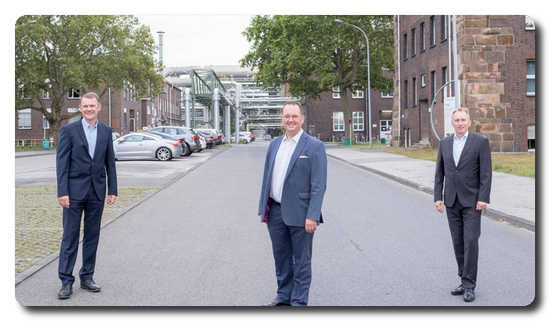 from left to right: Dr. Markus Winterberg (Vice President Production & Technology); Dr. Hinnerk Gordon Becker (Market Segment Head Specialties); Christian Bierhaus (Senior Vice President Marketing & Sales)
from left to right: Dr. Markus Winterberg (Vice President Production & Technology); Dr. Hinnerk Gordon Becker (Market Segment Head Specialties); Christian Bierhaus (Senior Vice President Marketing & Sales)
The products TBA, DiB and TMH are manufactured in the isobutene part of the production network. They are enjoying increasing demand and have high future growth potential. Hinnerk Becker, market segment manager for specialties at Performance Intermediates, explains: "Evonik has enormous expertise in the production of isobutene derivatives with high product and isomer purity. Our investment supports the high growth dynamics in the field of synthetic high-performance lubricants. We are also developing new applications for our petrochemical specialties. With the broadening of our range of isobutene derivatives, we are able to offer our customers an even better combination of supply reliability, flexibility and product quality."
The background to the investment in the Performance Intermediates business line is the ongoing development of so-called petrochemical specialties. These supplement the well-known classics such as MTBE, 1,3-butadiene or DINP and make a significant contribution to meeting the requirement of 100% material use of all raw material flows and thus to our sustainability strategy.
Background information on the products:
- TBA is available from EVONIK in two grades ('pure' and 'azeotropic') and is used, among other things, for the production of organic peroxides for the plastics industry, as a special solvent, and in the production of tablet coatings by the pharmaceutical industry.
- DiB is a highly branched C8 molecule. Due to its high purity, it can be used as an intermediate product for the production of UV stabilizers, high-performance lubricants and special polymer resins.
- TMH, as an aldehyde with high isomeric purity, is an intermediate product for the production of high-performance lubricants (especially cooling lubricants) and lubricant additives, as well as a component and intermediate product for special products in the cosmetics and fragrance industries.
Company information
Evonik is one of the world leaders in specialty chemicals. The company is active in more than 100 countries around the world and generated sales of €13.1 billion and an operating profit (adjusted EBITDA) of €2.15 billion in 2019. Evonik goes far beyond chemistry to create innovative, profitable and sustainable solutions for customers. More than 32,000 employees work together for a common purpose: We want to improve life, today and tomorrow.
ABOUT PERFORMANCE MATERIALS
The forever young classics of the Performance Materials Division stand for products and technologies that are continuously improved. They are the basis for many modern applications, for example in the areas of mobility, nutrition, pharmaceuticals or plastics. The division generated sales from continuing operations of around €2.04 billion in 2019 with about 1,600 employees. It is part of Evonik Operations GmbH.
Emerson Expands Commitment to Advanced Software Solutions with Agreement to Purchase Open Systems International, Inc. (OSI Inc.)
Leading software provides real-time management and optimisation across the smart grid
Emerson has just announced it has agreed to acquire Open Systems International, Inc. (OSI Inc.) for $1.6 billion in an all cash transaction. OSI Inc. is a leading operations technology software provider that broadens and complements Emerson’s robust software portfolio and ability to help customers in the global power industry, as well as other end markets, in their quest to transform and digitise operations to more seamlessly incorporate renewable energy sources and improve energy efficiency and reliability.
Digitisation is critical for the power industry to modernise and improve the reliability of the electric grid. Incorporating clean and renewable energy sources, such as solar and wind, requires balancing the variable nature of renewable energy with the often bi-directional demands of the grid. By combining Emerson’s domain expertise and leading technology in power generation with OSI Inc.’s complementary software and reach within the power transmission and distribution sectors, the acquisition will equip customers with the end-to-end ability to monitor, control and optimise real-time operations across the power enterprise through scalable, software-enabled automation and data management.
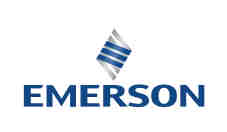 “An enormous change is underway as utilities globally are investing to digitise the grid and adapt to rapidly evolving energy sources and new technologies that increase consumer choices,” said Lal Karsanbhai, executive president of Emerson’s Automation Solutions business. “This acquisition will help the power industry maximize the remarkable opportunity to harness renewable energy sources and to accelerate the transformation to the smart power grid. Emerson now has the opportunity to be a leader in this large, rapidly growing market with a compelling and complete software and technology offering.”
“An enormous change is underway as utilities globally are investing to digitise the grid and adapt to rapidly evolving energy sources and new technologies that increase consumer choices,” said Lal Karsanbhai, executive president of Emerson’s Automation Solutions business. “This acquisition will help the power industry maximize the remarkable opportunity to harness renewable energy sources and to accelerate the transformation to the smart power grid. Emerson now has the opportunity to be a leader in this large, rapidly growing market with a compelling and complete software and technology offering.”
OSI Inc.’s advanced modular technology offers customers tailored solutions for their power grid management needs and is scalable to other industries. Combining this technology with Emerson’s Ovation control system, which is a market leader for power generation control, will provide utility customers with increased visibility into the current status of their power system, enabling unparalleled ability to optimize energy efficiency from generation through customer delivery – enabling the broader industry goal of minimising carbon footprint.
The acquisition will complement Emerson’s existing robust portfolio of software and automation technologies that support the world’s essential industries.
“Our $1 billion standalone software and associated engineering implementation services portfolio is quickly growing to meet customer needs and support operational performance, analytics and digital transformation,” Karsanbhai said. “OSI Inc. is a great business with a track record of high growth, strong profitability and long-term customer loyalty. This acquisition builds on Emerson’s software footprint and supports customers in providing comprehensive end-to-end solutions to help the power industry continue transforming to meet the needs of tomorrow.”
“Emerson and OSI share a commitment to excellent customer service and offering advanced technologies to help customers manage the reliability and resiliency of the electric grid,” said Bahman Hoveida, President & CEO of OSI Inc. “We are excited to combine our advanced technologies, engineering expertise and unsurpassed customer service not only to better serve our electric power customers but also to expand the reach of this critical software into other industries with the Emerson team.”
OSI Inc. is headquartered in Minneapolis, MN and has approximately 1000 employees globally. The acquisition is expected to close in early fiscal 2021, subject to various regulatory approvals and other customary closing conditions.
Centerview Partners LLC served as financial advisor and Davis Polk & Wardwell LLP served as legal advisor to Emerson. Wells Fargo & Co. and Lazard served as financial advisors and Fredrikson & Byron, PA served as legal advisor to OSI Inc.
About Emerson
Emerson (NYSE: EMR), headquartered in St. Louis, Missouri (USA), is a global technology and engineering company providing innovative solutions for customers in industrial, commercial and residential markets. Our Automation Solutions business helps process, hybrid and discrete manufacturers maximise production, protect personnel and the environment while optimising their energy and operating costs. Our Commercial & Residential Solutions business helps ensure human comfort and health, protect food quality and safety, advance energy efficiency and create sustainable infrastructure. For more information visit Emerson.com.
About OSI Inc.
Open Systems International, Inc. aka OSI Inc. (www.osii.com)—an American technology company headquartered in Minneapolis, Minnesota—provides open, state-of-the-art and high-performance enterprise automation solutions to utilities worldwide. These solutions include Supervisory Control and Data Acquisition (SCADA) systems, Energy Management Systems (EMS), Distribution Management Systems (DMS), Outage Management Systems (OMS), Generation Management Systems (GMS), Substation Automation (SA) Systems, Data Warehousing (Historian) Analytics, Distributed Energy Resource Management Systems (DERMS), Situational Awareness Systems, Pipeline Application Systems (PAS), individual software and hardware products, and Smart Grid solutions for utility operations. OSI's solutions empower its users to meet their operational challenges, day in and day out, with unsurpassed reliability and a minimal cost of technology ownership and maintenance.
IDEC Enhances MicroSmart FC6A Plus CPU with EtherNet/IP
The EtherNet/IP update for IDEC MicroSmart FC6A Plus PLCs is also a free upgrade for existing CPUs, enabling interconnection with many types of I/O systems and other intelligent automation devices.
IDEC Corporation announces an update to add EtherNet/IP™ communications to the MicroSmart FC6A Plus PLC. This update provides more options for end users, designers, and OEMs to integrate the FC6A Plus with many types of I/O systems and intelligent automation devices.
Expanded Connectivity Options
 The FC6A Plus is already expandable to support up to 2,060 I/O, making it ideal for controlling machines or small-scale manufacturing operations. With the addition of industry-standard EtherNet/IP scanner capabilities, the FC6A Plus can now connect with, monitor, and control any I/O, variable speed drive, motor controls, or other intelligent automation device using this popular industrial protocol. In addition, the FC6A Plus can be configured as an EtherNet/IP adapter, allowing it to interact with other peer and supervisory systems, such as PLCs and HMIs.
The FC6A Plus is already expandable to support up to 2,060 I/O, making it ideal for controlling machines or small-scale manufacturing operations. With the addition of industry-standard EtherNet/IP scanner capabilities, the FC6A Plus can now connect with, monitor, and control any I/O, variable speed drive, motor controls, or other intelligent automation device using this popular industrial protocol. In addition, the FC6A Plus can be configured as an EtherNet/IP adapter, allowing it to interact with other peer and supervisory systems, such as PLCs and HMIs.
Easy Upgrade Path
All new FC6A Plus CPUs will ship with the latest firmware and EtherNet/IP connectivity already installed and ready for use. For FC6A Plus CPUs already in service, users can obtain the current WindLDR software (version 8.15.0 or later) for free, and then use it to easily perform the upgrade. This ability to get the latest enhancements at no cost by field upgrading existing units is another benefit of using IDEC PLCs.
More Flexibility
Once a new or upgraded FC6A Plus CPU is deployed, Ethernet port 2 can be configured with the EtherNet/IP protocol. This enhanced connectivity gives users new options for architecting their machine and manufacturing operations. The already flexible FC6A Plus PLC platform can now interact with more industrial automation devices than ever before.
As with all its products, IDEC offers free tech support for the FC6A family of PLCs, with no service or support contract required. For complete specifications or additional information, please contact IDEC Corporation at 800-262-IDEC (4332), or visit us online at http://FC6A.IDEC.com .
The perfect balance for large rotors
Drive motor upgrade delivers improved flexibility and efficiency for Sulzer’s high-speed balancing facility
High-speed balancing facilities are used to ensure optimum performance of large pieces of rotating equipment, such as steam or gas turbines. Sulzer operates two of the very few independent facilities in the world and the site in Texas, U.S.A., recently underwent an upgrade project to improve both its flexibility and efficiency.
Electrical generators are vital to creating the electricity we all use in our everyday lives and with increasing demand reliable performance is essential to minimize the risk of blackouts. Sulzer is supporting these important assets with a comprehensive range of maintenance services, including high-speed balancing.
The independent, high-speed balancing facility in La Porte, Texas, is a specialist piece of diagnostic equipment that is designed to test some of the largest turbine rotors in the world. Equipped with a vacuum chamber, it can run complete turbine rotor assemblies at full operating speed, and beyond if necessary. The installation minimizes the time required to balance a rotor and the latest upgrade will reduce that time even further.
The bunker itself is designed to accommodate turbomachinery up to 30 feet (9 meters) in length, 8.5 feet (2.59 meters) in diameter, and up to 50’000 lbs (23 tonnes) in weight to speeds up to 40’000 rpm. Vibration diagnostics are used to analyze the radial vibration at the bearings to ensure that the best balance is achieved at operating speed as well as minimizing the deflection and vibration amplitudes during ramp up and coast down.
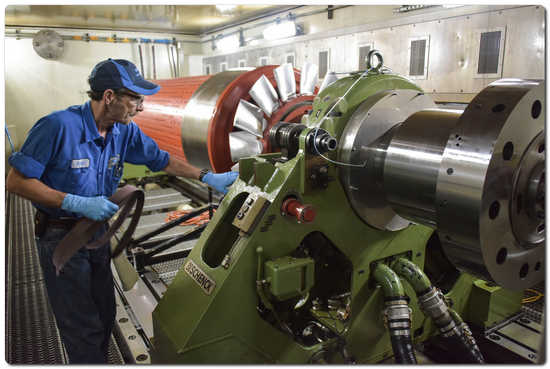 The installation minimizes the time required to balance a rotor and the latest upgrade will reduce that time even further.
The installation minimizes the time required to balance a rotor and the latest upgrade will reduce that time even further.
Taking stock
The original installation used two 500 hp (370 kW) direct current (DC) motors that were installed in the 1990s. The two motors were connected inline, giving a 1’000 hp (740 kW) output, and could be operated independently. These were connected to a three-speed gearbox, which in turn was connected to a single-gear speed increaser. There is also the capability to add a third gearbox which is a turbo-drive.
The design of the drive system offered a maximum capacity of 150% of the motor power for a short period of time to start the rotor rolling. This equated to a maximum of 1’500 hp (1’110 kW) dual motor drive that could be configured to turn the rotor at, or above, its normal operating speed.
Having achieved the balancing assessment at a particular speed, a rotor needs to be brought back to a standstill to apply balance weights before the procedure can continue. With the old system, a regeneration drive acted as a brake, and also fed the energy generated by the slowing rotor, back into the grid.
Drive upgrade
The upgrade project would involve replacing the motors with alternating current (AC) alternatives, also rated at 500 hp, and new drives. The new drive motors can run briefly at 250% of the nominal rating, offering 2500 hp (1’850 kW) that can be used to start larger rotors rolling, increasing the capacity of the facility.
The new system remains as a dual motor drive, but now the motors are always operated together and share the load between them, with the second motor fitted with an encoder that is used to calculate the speed of the rotor. The two drives are also linked together in a master/follower arrangement to ensure optimum performance of the motors.
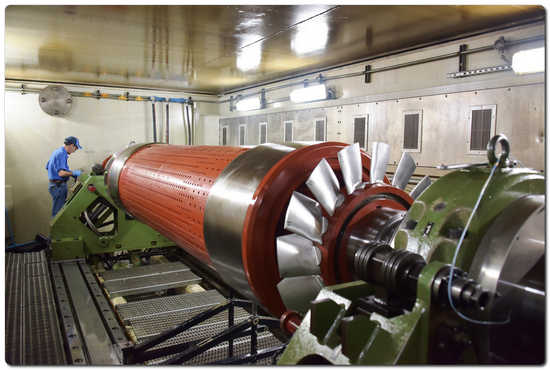 Sulzer can balance turbomachinery up to 30 feet (9 meters) in length, 8.5 feet (2.59 meters) in diameter, and up to 50’000 lbs (23 tonnes) in weight to speeds up to 40’000 rpm
Sulzer can balance turbomachinery up to 30 feet (9 meters) in length, 8.5 feet (2.59 meters) in diameter, and up to 50’000 lbs (23 tonnes) in weight to speeds up to 40’000 rpm
Gaining control
The original control system allowed the engineers to input inertia settings, which took account of many variables relating to the rotor being balanced including weight, length and blade/impeller design. Rotors could be classified into one of six inertia groups and this would determine the configuration of the balancing drive system. These settings were fine-tuned over many years of operation but there was still some room for improvement.
To complete a balancing procedure, the engineers input the desired speed setpoint and the motors are engaged to start the rotor turning and then bring it up to the required speed.
Using vibration diagnostics to analyze the radial vibration at the bearings and the mid-span deflection is essential to ensuring that the best balance is achieved at operating speed as well as minimizing the deflection and vibration amplitudes during ramp up and coast down.
Process improvements
The new system uses precision torque control to regulate the speed of the rotors being balanced and this offers considerable refinements to the original system. The initial torque required to start the rotor turning can be minimized, reducing energy consumption. In addition, the torque required to bring a rotor up to a pre-set speed can also be optimized, being reduced as the target speed approaches.
The improved accuracy in speed control offers a more stable platform to conduct the balancing procedures, while the improved ability to accelerate and decelerate the rotor all combine to reduce the overall time required to complete the balancing procedure. At the same time, the regeneration drive continues to act as a brake and recover a large percentage of the energy used to accelerate the rotor on each cycle.
In addition, the gear ratios of the gearboxes have been programmed into the drive system and the encoder can calculate the speed of the rotor, based on the gear selection that is being used. The improved control system offers much greater precision and flexibility as well as reducing the amount of time required to complete a balancing procedure.
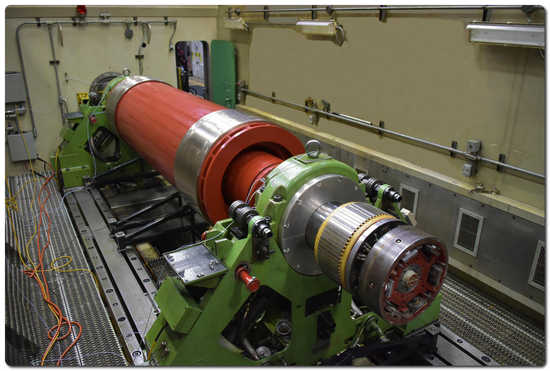 The new drive motors can run briefly at 250% of the nominal rating, offering 2500 hp (1’850 kW) that can be used to start larger rotors rolling.
The new drive motors can run briefly at 250% of the nominal rating, offering 2500 hp (1’850 kW) that can be used to start larger rotors rolling.
Long-term benefits
Despite having the same power rating, the new motors are considerably smaller than the originals, reducing the overall power train length by 3 feet (900 mm). They are also much more energy efficient, reducing the overall costs for the facility.
However, the biggest gain has been in the control system, which is now a digital, touch-screen installation. The entire balancing facility can be operated from two human-machine interfaces (HMIs) that offer greater control and precision. The modern drives and the encoder provide better speed control, allowing the balancing software to deliver even more accurate results.
The next investment will involve upgrading the gearboxes, to allow the full potential of the new motors to be realized. In the meantime, the demand for this facility continues to rise as larger rotors can now be accommodated and customers’ projects can be completed on shorter lead times.
About Sulzer
Sulzer is a global leader in fluid engineering. We specialize in pumping, agitation, mixing, separation and application technologies for fluids of all types. Our customers benefit from our commitment to innovation, performance and quality and from our responsive network of 180 world-class production facilities and service centers across the globe. Sulzer has been headquartered in Winterthur, Switzerland, since 1834. In 2019, our 16’500 employees delivered revenues of CHF 3.7 billion. Our shares are traded on the SIX Swiss Exchange (SIX: SUN).
Throughout the Americas, Sulzer provides cutting-edge parts as well as maintenance and repair solutions for pumps, turbines, compressors, motors and generators. We service our own original equipment as well as third-party rotating equipment operated by our customers. Our technology-based solutions maximize reliability and lifecycle cost effectiveness.
For more information on Sulzer, visit www.sulzer.com
Stora Enso to build a pilot plant for bio-based packaging foam
Stora Enso will build a pilot facility for producing Cellufoam™ by Stora Enso, a lightweight, fiber-based foam material for protective packaging and cushioning. Bio-based foams are renewable and recyclable and can be used in packaging, for example, to replace oil-based polymer foams which are widely used today. The pilot plant will be located at Stora Enso’s Fors Mill in Sweden.
 Cellufoam™ by Stora EnsoCellufoam™ by Stora Enso is a sustainable packaging material and it further increases Stora Enso’s opportunities to replace fossil-based materials with renewable and recyclable materials. The initial target application for Cellufoam™ will be the protective packaging of fragile products, for example in consumer electronics. Bio-based foams also have the potential to replace polymeric foams in a range of markets and applications where the demand for sustainable materials is increasing, such as sports equipment, thermal insulation in shipments and as a growth medium in soil-free farming, among other areas.
Cellufoam™ by Stora EnsoCellufoam™ by Stora Enso is a sustainable packaging material and it further increases Stora Enso’s opportunities to replace fossil-based materials with renewable and recyclable materials. The initial target application for Cellufoam™ will be the protective packaging of fragile products, for example in consumer electronics. Bio-based foams also have the potential to replace polymeric foams in a range of markets and applications where the demand for sustainable materials is increasing, such as sports equipment, thermal insulation in shipments and as a growth medium in soil-free farming, among other areas.
“The interest in sustainable packaging solutions is already large and continuously growing. Companies are looking for bio-based materials in order to achieve their own environmental goals for recycling, reducing plastic waste and using fossil-free materials, while maintaining high-quality packaging performance,” says Markus Mannström, Executive Vice President of Stora Enso’s Biomaterials division. “Our bio-based foam offers a renewable, recyclable and biodegradable alternative to traditional oil-based packaging foams such as expanded polyethylene (EPE) and expanded polystyrene (EPS). With this pilot, we continue to build on our long-term R&D work while introducing innovative materials to replace fossil-based ones,” Mannström says.
Stora Enso’s pilot aims to evaluate and validate Cellufoam™ as a packaging foam in customer tests and to further develop the production process. The new pilot plant will be part of Stora Enso’s Biomaterials division.
The design and engineering of the pilot facility will start immediately. It is estimated that the plant will be ready in the fourth quarter of 2021. Decisions about commercialisation will follow, after evaluating the results of the pilot-scale production.
Stora Enso’s Fors Mill today produces world-class light-weight paperboards for consumer packaging. The modern mill’s energy production is free from fossil-CO2 emissions. The pilot plant investment will not impact the mill’s current production.
Another £1 million fleet addition for McLachlan Marine Aberdeen
A leading operator of inshore workboats based in the North East of Scotland has invested a further £1 million in a unique addition to its growing fleet.
McLachlan Marine recently unveiled the 19-metre, Multicat “Ocean Supporter” as a significant addition which will be fundamental in capitalising on opportunities in emerging sectors including renewables and marine construction. The only vessel of its kind based in the area, “Ocean Supporter” is designed for inshore work up to 60 miles out and can cope with up to 40 tonnes of cargo on deck. It has already been busy transferring supplies to boats at anchor off Aberdeen during the Covid-19 pandemic, and supporting dive and marine civil activities on the Aberdeen Harbour Expansion Project.
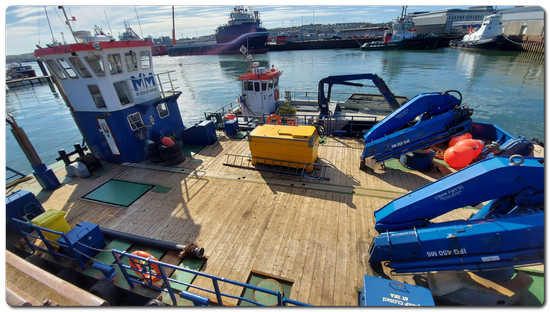
The sizeable investment follows the earlier introduction of the company’s landmark tenth boat, the £1 million, game-changing, 26-metre “Ocean Titan” offshore windfarm support/ survey vessel with a top speed of 26 knots and MCA-certified up to 60 nautical miles offshore, facilitating faster support further out to sea.
The self-styled: “Swiss army knife of workboat operators,” McLachlan Marine was established in 2011 and is independently operated under the guidance of owner and MD, Ruari McLachlan. Strategically headquartered at Fordoun within easy reach of the busy harbours of Aberdeen, Montrose and Dundee, the company also has quayside facilities and office at Aberdeen Harbour and an additional office in Montrose.
Ruari McLachlan, said: “Since we purchased our first boat in 2011, we have worked hard to evolve in line with growing market demands for our services and vessels across the offshore wind and oil and gas sectors. Having invested £2 million this year alone, we are confident and optimistic about the opportunities which lie in the future, once ‘new normal’ is established.
“With our strategic local infrastructure and the variety of vessels in our portfolio, we are correctly positioned to work with our clients to meet their needs on a range of projects, backed by a strong track record of expertise, safety and reliability.”
For further information visit http://www.mclachlanmarine.com
Established in 2011 and strategically located between Aberdeen and Dundee, McLachlan Marine owns and operates a growing fleet of marine support vessels for the offshore wind and oil and gas sectors. With a diverse profile of projects, services and a quayside base at Aberdeen Harbour the company provides crew launch, crew transfers, workboat hire, safety boats, seabed survey boats, equipment sea trials and equipment deployments. The company provides the highest levels of service, with an overriding focus on safety. Designed and built to the highest standards, the expanding fleet and variety of vessels ensures the right vessel can be offered for each project. For further information visit http://www.mclachlanmarine.com
GrInHy2.0: Sunfire delivers the world’s largest High-Temperatur Electrolyzer to Salzgitter Flachstahl
Sunfire has successfully delivered the world’s most powerful High-Temperature Electrolyzer (HTE) for highly energy-efficient hydrogen production to Salzgitter Flachstahl GmbH. Within the GrInHy2.0 project, Sunfire’s HTE system with a rated electrical output of 720 kilowatts will be deployed in an industrial environment for the first time. GrInHy2.0 is another step by Salzgitter AG towards low CO2 steel production within the framework of the innovation project SALCOS® - Salzgitter Low CO2 Steelmaking. The electrolyzer is expected to be in operation for at least 13,000 hours by the end of 2022, while producing at least 100 tons of green hydrogen from renewable electricity.
"In the course of the recently adopted hydrogen strategies of the European Union and Germany, politicians pointed out the need for large scale electrolyzers for the production of sustainable steel products. Green steel requires green hydrogen and the implementation of GrInHy2.0 showcases the great potential of this energy carrier for energy-intensive industries” said Nils Aldag, Managing Director of Sunfire GmbH “At present, the steel industry is intensively developing new and low-CO2 production routes. We are pleased to participate in this together with our partners. The technology is ready for hydrogen production on an industrial scale, and we are ready to significantly increase our production capacity for this purpose".
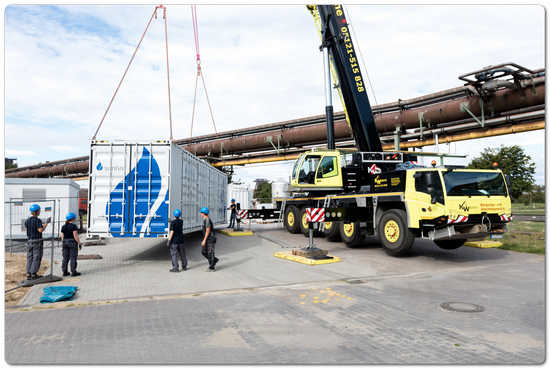
Salzgitter Flachstahl GmbH and Sunfire have already pioneered the GrInHy project in 2016. In cooperation with its partners Paul Wurth S.A., Tenova SpA, the French research center CEA and Salzgitter Mannesmann Forschung GmbH, GrInHy2.0 will now continue to build on the success of the initial project.
Dr. Benedikt Ritterbach, Managing Director of Salzgitter Mannesmann Forschung GmbH and responsible for research and development in the Salzgitter Group: "Green hydrogen is a central building block on our way to low CO2 steel production. GrInHy2.0 will provide us with further findings in the industrial demonstration operation of a High-Temperature Electrolyzer. By integrating this world's most powerful plant into large-scale industrial processes, we are breaking new ground in energy-efficient hydrogen production".
This project has received funding from the Fuel Cells and Hydrogen 2 Joint Undertaking (JU) under Grant Agreement No 826350. This Joint Undertaking receives support from the European Union’s Horizon 2020 Research and Innovation programme , Hydrogen Europe and Hydrogen Europe Research.
About Sunfire
Founded in 2010, Sunfire GmbH develops and manufactures High-Temperature Electrolyzers (SOECs) and High-Temperature Fuel Cells (SOFCs). The company employs a workforce of 170. High-Temperature Electrolysis is a process used to produce valuable hydrogen from water. It is particularly efficient and is powered by renewable electricity. In the latest version, High-Temperature Electrolysis can reactivate not only water but also CO2 and thereby convert exhaust gases directly back into a clean raw material which can take the place of oil or natural gas. This means that the entire transport sector and many industrial processes which are currently dependent on oil, gas or coal can become uncompromisingly sustainable and CO2-neutral.
For more information please visit www.sunfire.de
About Salzgitter
Salzgitter AG is one of Europe’s leading steel and technology groups – with external sales of around 9 billion euro, a workforce of over 25,000 and just under 160 national and international subsidiary and associate companies. It is comprised of the Rolled Steel, Plate/Sections, Mannesmann, Trading and Technology business units. Salzgitter Flachstahl GmbH is the largest subsidiary, producing a broad range of high-quality special and branded steels for demanding customer segments such as the automobile industry. Salzgitter Mannesmann Forschung GmbH is the central research unit supporting the steel activities of the Salzgitter Group.
Details of the Salzgitter Group are available online at www.salzgitter-ag.com. Information about the GrInHy and SALCOS projects is available at https://salcos.salzgitter-ag.com and http://www.green-industrial-hydrogen.com
About Paul Wurth
Headquartered in Luxembourg since its creation in 1870, the Paul Wurth Group is an established technology provider for the global ironmaking industry. Paul Wurth is a leading market player for the design and construction of complete blast furnace and coke oven plants. Direct reduction plants, environmental protection solutions and recycling technologies complete Paul Wurth’s product portfolio. Presently, the company is focusing on the development of innovative solutions for leading the decarbonisation of the metals industry. With more than 1500 employees, Paul Wurth is active worldwide, operating entities and affiliated companies in the main iron and steelmaking regions of the world.
For further information, please visit www.paulwurth.com
About Tenova
Tenova, a Techint Group company, is a worldwide partner for innovative, reliable and sustainable solutions in metals and mining. Tenova, including its TAKRAF affiliates, leverages a workforce of over 2,500 forward-thinking professionals located in 19 countries across 5 continents, who design technologies and develop services that help companies reduce costs, save energy, limit environmental impact and improve working conditions.
For more information please visit: www.tenova.com
About CEA
The CEA is a French public research organization, working in four main areas: energy transition (nuclear and renewable), digital transformation for industry, future health technologies, defense and security. Based on an excellent fundamental research, with its 20,000 employees and its research centers with impressive infrastructures, the CEA is a major player in European research.
Its Institute CEA-Liten, employing 1,000 people, is fully dedicated to the activities on new technologies for renewable energy and energy efficiency. It is involved in various national and EU research and demonstration projects related to high temperature electrolyzers and/or fuel cells (SOEC/SOFC) and their integration on the electric system in presence of large renewable energy sources.
Further information at www.liten.cea.fr
